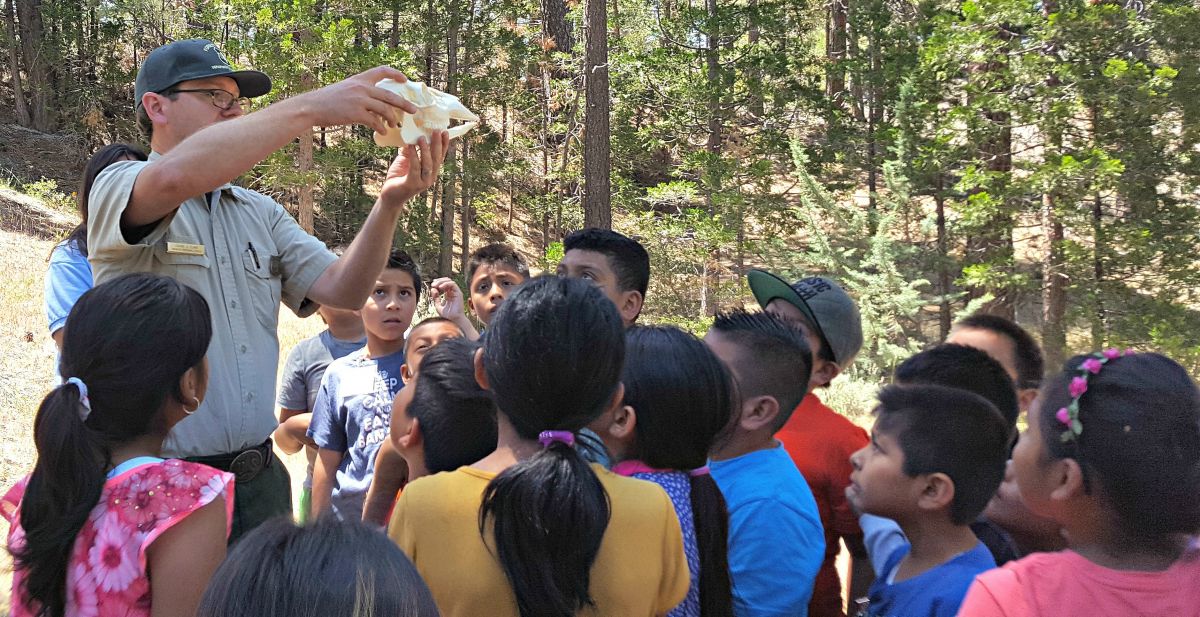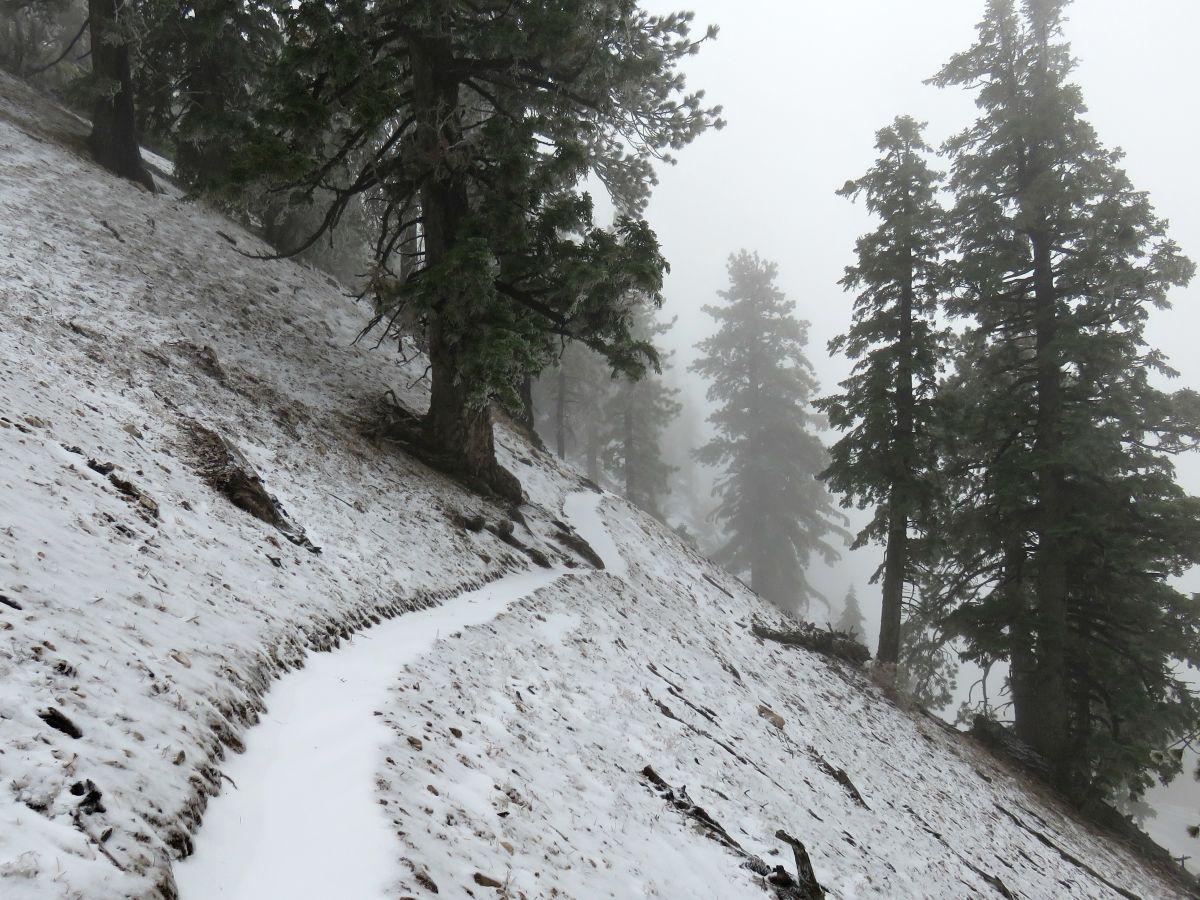 |
| A ranger explains how animal jaws work to La Esperanza Elementary fourth-graders during a Sierra Club-sponsored visit to the San Gabriel Mountains National Monument. The Forest Service makes no commitment supporting youth activities in its draft monument management plan. Photo by Roberto Morales. |
Buildings have blueprints; national monuments have management plans. The U.S .Forest Service has just released its long-awaited draft management plan for the 346,000-acre San Gabriel Mountains National Monument, which was established by President Obama in 2014. The presidential proclamation that created the designation also stipulated a three-year deadline for completing the plan.
Monument plans are important since they define its overall direction and key objectives for decades to come. The document itself – almost 200 pages long -- is a surprising mix of progressive elements, glaring omissions and a lack of accountability.
“I take youth and kids into the National Monument all the time,” said Roberto Morales, Sierra Club associate organizer. “It is often their first experience with nature, and it makes a deep impression on them. But the draft monument plan makes no commitment to helping to get kids outdoors. Nowhere in the plan does the Forest Service actually commit to doing anything.”
The good news is that activists and hikers have one last chance to ask the Forest Service to improve the plan. The agency is hosting five public meetings over the next few weeks, including a webinar on Sept. 10 and meetings in downtown Los Angeles on Sept.14 and Arcadia on Sept. 17. (See locations and details below.)
Sierra Club members dominated public comments last year on the national monument, which lead directly what progressive elements there are in the plan.
 |
|
The San Gabriel Mountains National Monument in winter. This photo shows the Dawson Saddle Trail to Mt. Baden Powell which links to a section of the Pacific Crest Trail. The Forest Service management plan needs to make a clear commitment to trail maintenance and improvement. Photo by John Monsen
|
Recommended comments
Here is everything you need to know to submit comments, which can be entered at this link. Comments are highly valued; please help out today by making one or more of the points listed below.
- Ask that a glaring omission be corrected. Although the plan offers some reasonable “desired conditions,” it makes no specific commitment to the million-plus people who visit the monument each year. The Forest Service can do better. Call on the agency to set clear objectives that will improve the visitor experience. Ask the agency to state that one of its top goals is to provide outstanding visitor services and recreational opportunities. This would include interpretive bilingual signage and visitor educational materials, visitor kiosks, a comprehensive trail plan and trail improvements, volunteer engagement and stewardship programs, field rangers, visitor education programs with nature appreciation elements, and programs for youth of diverse backgrounds.
- Ask for clear objectives with completion timelines for accountability. Ask that the plan remove language that offers wiggle room like “maintain awareness” and “improve” and replace it with specific objectives. Ask the Forest Service to add completion timelines to the plan for accountability.
- Give credit where it is due. Thank the Forest Service for recognizing the need for outreach to youth and communities of color (although they need to specify how they plan to do it). And thank them for recognizing the need for a transportation plan to link transit to trails. This could improve access from underserved communities and make it easier for everyone to reach crowded trailheads such as Chantry Flats and East Fork along the San Gabriel River from public transit such as the Gold Line. This will also help reduce the carbon footprint of visitors, almost all of whom currently arrive by car.
- Ask the agency to protect the valuable natural assets in the monument. The presidential proclamation establishes that all of the valuable “objects” (the proclamation’s term) in the monument be protected, from aquatic species and diverse wildlife to scientific features (such as the Mt. Wilson Observatory) and archeological sites. Ask that the management plan list how each will be protected.
The monument plan document, called an Environmental Assessment, can be found here. Got questions? Public meetings will be held to answer questions and provide additional information, at the following locations and times. These are open house meetings, so you can come any time. Sierra Club Forest Committee and San Gabriel Mountain Forever volunteers will be outside near entrances with information and suggested comments. We can always use more volunteers! It's fun and contributes to a great cause.
To help out, contact Rob Morales at Roberto.Morales@sierraclub.org
Here are places to go to make your voice heard on the plan for San Gabriel Mountains National Monument.
• Sept. 10, 1-3 pm., Webinar, Registration
• Sept. 14, 3-8 pm, Pico House, 430 N Main St. Los Angeles
• Sept. 15, 4-8 pm, The Centre, 20880 Centre Pointe Pkwy Santa Clarita
• Sept. 17, 10 am – 2 pm, ANF Headquarters, 701 North Santa Anita Ave., Arcadia
• Oct. 4, 3:30-7:30 pm, Big Pines Lodge, Angeles Crest Highway (Highway 2) Wrightwood
John Monsen is Co-Chair of the Angeles Chapter’s Forest Committee and a consultant to the National Field Staff. He works on the San Gabriel Mountains Forever campaign. Roberto Morales works on the Sierra Club's field staff in Southern California.